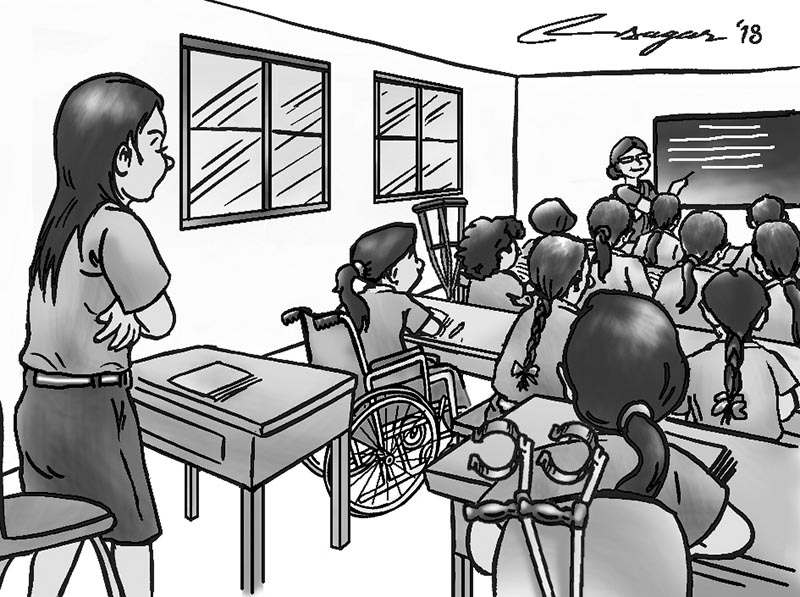Inclusion in education: Ensure equal opportunity
There is a huge educational exclusion among children with disabilities. With Nepal’s remarkable achievement in school enrolment rates, the common challenge is now to attain equitable education for children with all types of learning abilities
Inclusive education has gained significant importance globally in recent times, both as a concept and practice. It is one of the fundamental ways to welcome diversity amongst all learners. Considering the astoundingly high number of children with disabilities not getting enrolled in schools—and one third of them dropping out without completing basic education—disability inclusive education has become a major concern for all stakeholders.
There is a huge educational exclusion among children with disabilities. With Nepal’s remarkable achievement in school enrolment rates, the great common challenge is now to attain equitable education for children with all types of learning abilities. National and international studies have shown that exclusion of children with disabilities starts from very early in their life. Therefore a holistic vision of education, acknowledging the importance of early interventions to improve their well-being which also prepares children with disabilities for primary schools and successful transition, is a must.
If children with disabilities receive proper opportunities, their families and they themselves will be out of the risk of falling into chronic poverty trap.
Among many others, comprehensive policy and meaningful leadership are the most important aspects for effective inclusive education. As a signatory of the United Nations Convention on the Rights of Persons with Disabilities, and after the promulgation of the Constitution and Disability Act and inclusive education policies, one can confidently say that the impetus to inclusive education is well established at the policy level in Nepal. It is high time we started developing realistic implementation plans with a clear framework to ensure that all stakeholders are knowledgeable to promote and support inclusion of children with disabilities in schools and communities.
Another important component is classroom and school environment that include capacity of teachers to ensure that inclusive learning environment is created for the diverse learning needs of children. Inclusive classroom ideally indicates a class full of diversity of learners where children without disabilities can interact and learn from children with disabilities. For that, teachers will need an inclusive approach to provide instruction to a diverse group of students. It encompasses collaboration with parents of children with disabilities and teachers to instruct diverse types of students with disabilities, enabling school environment in partnership with rehabilitation centres. This is easier said than done but sustained effort from the concerned stakeholders can help realise this goal.
Considering that several textbooks are not fully accessible to children with specific types of disabilities in Nepal, there is a knowledge gap among children with visual or hearing or learning difficulties. Teachers therefore need to identify an instructional strategy to support these children considering their learning needs and strengths by using the braille, sign language and other necessary tools.
For example, children with learning disabilities may not do great in memorising and writing exams, but they can perform better in participation, fun games and other activities. So the objective of the inclusive education should be to engage students in the session that ensures meaningful learning for all types of pupils. Assessment of the students’ performance is another very important factor on inclusive education. Simple and effective tests to examine the reading and learning skills help assess their capacity.
Next component which is central to ensure inclusive work is the “development of learning materials and instructional practices” that are helpful for both mainstream and resource teachers to manage their day-to-day tasks. There are some materials developed by different organisations in partnership with the inclusive education section and other departments with the Ministry of Education. Increasingly, there is a need of private sector engagement to promote inclusive education.
In several countries in the West, private companies have been contributing to promote inclusive education practices in school—especially in the use of advanced technology and computer-based learning to help teachers meet the needs of diverse children. Microsoft in several countries has helped teachers to use computer-based technologies in order to meet distinct need of children with disabilities. Nepal’s corporate houses and private sector need to start investing for bringing new technology into the classrooms as part of their corporate social responsibility.
In conclusion, there is no “one size fits all approach” to resolve all associated challenges and exclusionary practices on disability inclusive education in Nepal. Focus should be on identification of children with disabilities and then to address various barriers that are preventing them from going to school. Classrooms should be inclusive, non-discriminatory, culturally sensitive and gender-friendly. Teachers must be supported with a variety of toolkits, strategies and practices. Lastly, there must be a strong monitoring mechanism to capture the lessons learned, and feedbacks from parents and students should be properly incorporated.
Neupane is associated with Humanity and Inclusion Nepal






